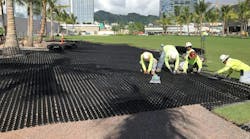Nashville, TN, has a watershed of 311,212 acres. Annual rainfall is 48.5 inches. But those figures don’t mean much if what happened in Nashville on May 1–2, 2010—or something close to it—happens again.
That Saturday, 6.3 inches of rain fell in a 24-hour period. Over 12 hours on Sunday, the city received another 7.2 inches of rain. It was the heaviest rainfall ever recorded in Nashville, and resulted in massive flooding.
Nashville, TN, has a watershed of 311,212 acres. Annual rainfall is 48.5 inches. But those figures don’t mean much if what happened in Nashville on May 1–2, 2010—or something close to it—happens again.
That Saturday, 6.3 inches of rain fell in a 24-hour period. Over 12 hours on Sunday, the city received another 7.2 inches of rain. It was the heaviest rainfall ever recorded in Nashville, and resulted in massive flooding.
[text_ad]
In some sections of the city, cleanup went on for months afterward. Because of the flood, EPA even granted Nashville an extension of time for work related to the consent decree it had levied on the city.
“The May 2010 flood reinforced to us how important it is to apply our stormwater regulations to new developments, and especially to the repair of flood damaged structures,” says Tom Palko, assistant director of the Stormwater Division, Metro Water Services (MWS).
He adds, “We aggressively pursued mitigation funding from FEMA [the Federal Emergency Management Agency] to purchase flood damaged properties and restore those areas to open space. We will continue to look for similar opportunities in the future. We need to do everything we can to mitigate structures that are prone to repetitive losses.”
“Rain in Nashville tends to be heavy and of short duration. The bottom drops out and we get a ton of rain,” says Sonia Allman, a former environmental compliance officer in the Stormwater Division of MWS and now the public information officer.
Check out Forester Media's directory for detailed information from our partners in water: green infrastructure, smart meters, stormwater drainage and management, water quality monitoring and water treatment. For additional information from our water partners, visit our Water Directory.
Allman, who has been involved in public outreach and other jobs related to various stormwater projects in Nashville, says that the Cumberland River presents her city with challenges for managing its stormwater.
The river “has lots of tributaries and some very flashy streams.” Add in “a lot of floodplain areas, because in the 1950s and 1960s there were no regulations against building homes there,” she explains.
The city has bought a lot of homes in these floodplain neighborhoods, torn down the buildings, and left the land vacant. Building codes are stricter now, too.
“We require four feet above base elevation. FEMA only requires one foot,” says Allman.
Reflecting on the flood, Rebecca Dohn, low-impact development and sustainability coordinator for MWS, says, “One of the more interesting (to us) impacts on policy was the affirmation that our existing stormwater regulations were fairly protective. After evaluating our four-feet-above-base-floor-elevation requirement for residential, our stakeholder committee decided we were adequately conservative.”
Allman sees water quality as another challenge to managing stormwater in Nashville. Because water is plentiful, “people don’t always appreciate it and don’t want to protect it. Our stormwater fee was just implemented in 2009. It’s only three dollars a month, but there was a big public outcry.”
Palko says funding “is a constant challenge. Currently we have a stormwater user fee in place that provides funding for our program, but those funds provide only a limited ability to construct capital projects to address stormwater concerns.”
[text_ad use_post='27751']
Dohn sees another challenge. “The one-inch requirement will become a mandate in Nashville in early 2016. Middle Tennessee has a lot of karst topography, and it will be difficult to integrate green infrastructure in some areas.”
She adds, “Nashville’s challenge will be to give site designers flexibility, while still protecting water quality. In return, we hope our engineers will work creatively to design around a both a site’s constraints and its beneficial environmental features.”
Even with sudden heavy rains, Nashville is managing its stormwater through various chords that allow green infrastructure to resound. Acquisition of open green space, financial incentives for green roofs, revitalization of the city’s riverfront, and installation of Complete Streets and other public and private projects show that green infrastructure is humming along nicely in Nashville.
In some sections of the city, cleanup went on for months afterward. Because of the flood, EPA even granted Nashville an extension of time for work related to the consent decree it had levied on the city.
“The May 2010 flood reinforced to us how important it is to apply our stormwater regulations to new developments, and especially to the repair of flood damaged structures,” says Tom Palko, assistant director of the Stormwater Division, Metro Water Services (MWS).
He adds, “We aggressively pursued mitigation funding from FEMA [the Federal Emergency Management Agency] to purchase flood damaged properties and restore those areas to open space. We will continue to look for similar opportunities in the future. We need to do everything we can to mitigate structures that are prone to repetitive losses.”
“Rain in Nashville tends to be heavy and of short duration. The bottom drops out and we get a ton of rain,” says Sonia Allman, a former environmental compliance officer in the Stormwater Division of MWS and now the public information officer.
Check out Forester Media’s directory for detailed information from our partners in water: green infrastructure, smart meters, stormwater drainage and management, water quality monitoring and water treatment. For additional information from our water partners, visit our Water Directory.
Allman, who has been involved in public outreach and other jobs related to various stormwater projects in Nashville, says that the Cumberland River presents her city with challenges for managing its stormwater.
The river “has lots of tributaries and some very flashy streams.” Add in “a lot of floodplain areas, because in the 1950s and 1960s there were no regulations against building homes there,” she explains.
The city has bought a lot of homes in these floodplain neighborhoods, torn down the buildings, and left the land vacant. Building codes are stricter now, too.
“We require four feet above base elevation. FEMA only requires one foot,” says Allman.
Reflecting on the flood, Rebecca Dohn, low-impact development and sustainability coordinator for MWS, says, “One of the more interesting (to us) impacts on policy was the affirmation that our existing stormwater regulations were fairly protective. After evaluating our four-feet-above-base-floor-elevation requirement for residential, our stakeholder committee decided we were adequately conservative.”
Allman sees water quality as another challenge to managing stormwater in Nashville. Because water is plentiful, “people don’t always appreciate it and don’t want to protect it. Our stormwater fee was just implemented in 2009. It’s only three dollars a month, but there was a big public outcry.”
Palko says funding “is a constant challenge. Currently we have a stormwater user fee in place that provides funding for our program, but those funds provide only a limited ability to construct capital projects to address stormwater concerns.”
Dohn sees another challenge. “The one-inch requirement will become a mandate in Nashville in early 2016. Middle Tennessee has a lot of karst topography, and it will be difficult to integrate green infrastructure in some areas.”
She adds, “Nashville’s challenge will be to give site designers flexibility, while still protecting water quality. In return, we hope our engineers will work creatively to design around a both a site’s constraints and its beneficial environmental features.”
Even with sudden heavy rains, Nashville is managing its stormwater through various chords that allow green infrastructure to resound. Acquisition of open green space, financial incentives for green roofs, revitalization of the city’s riverfront, and installation of Complete Streets and other public and private projects show that green infrastructure is humming along nicely in Nashville.






